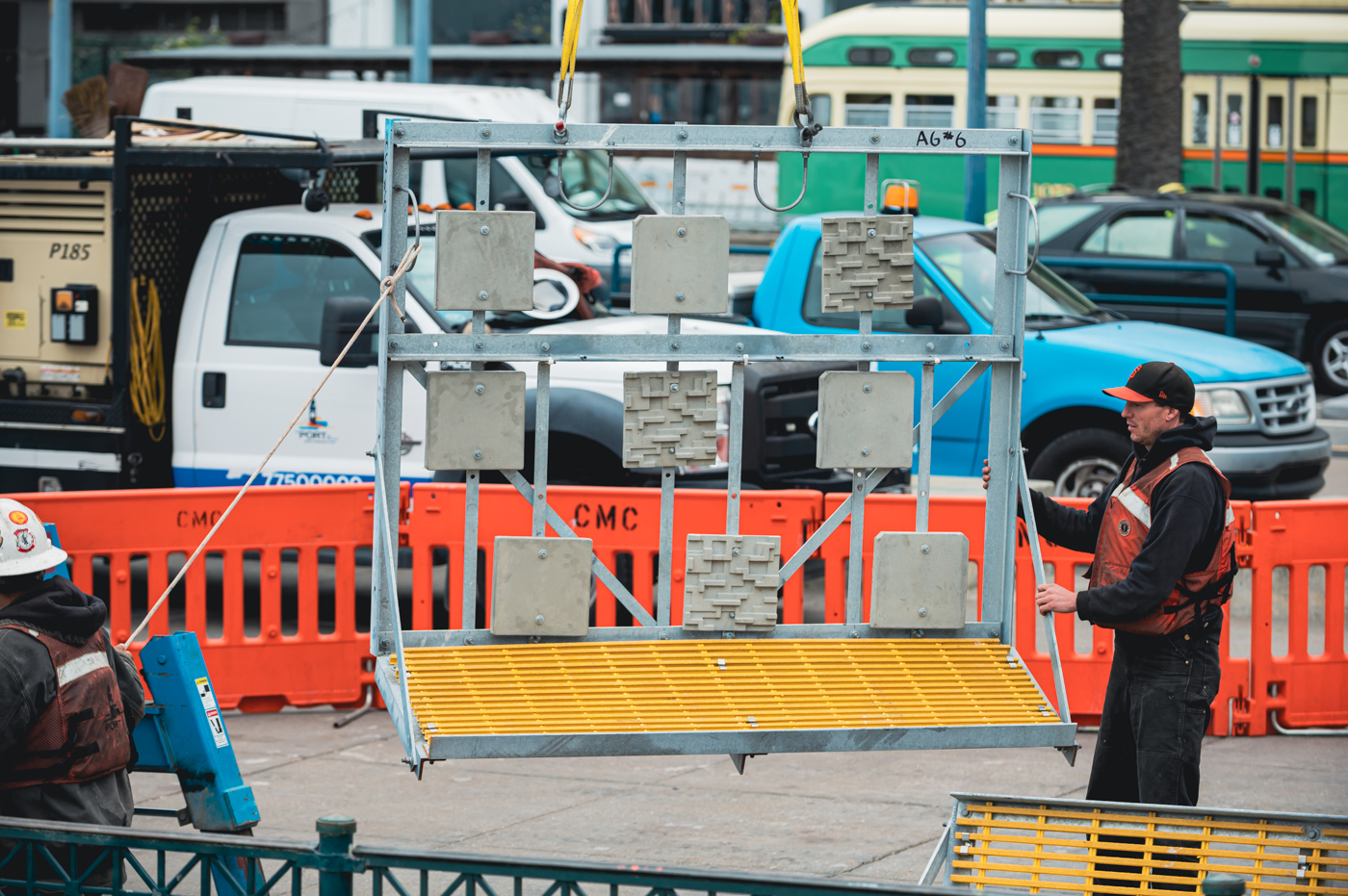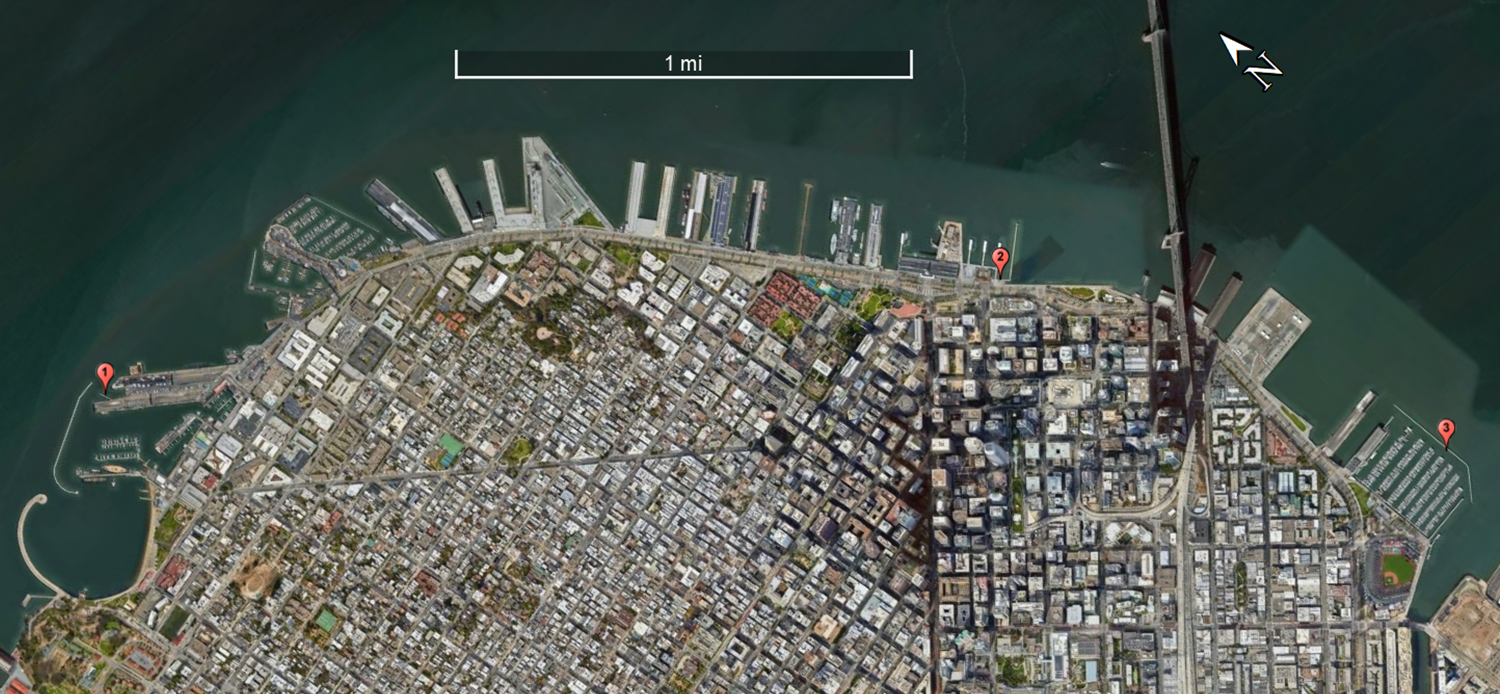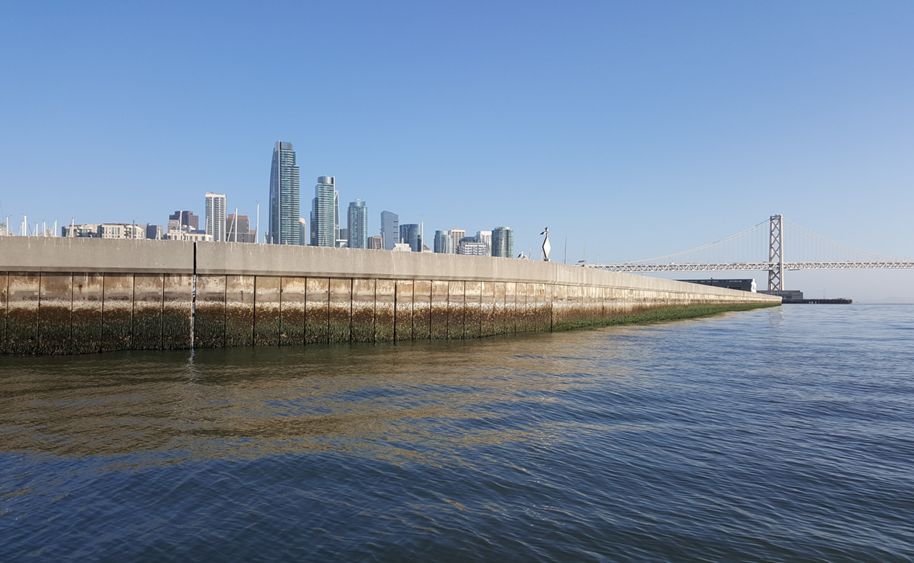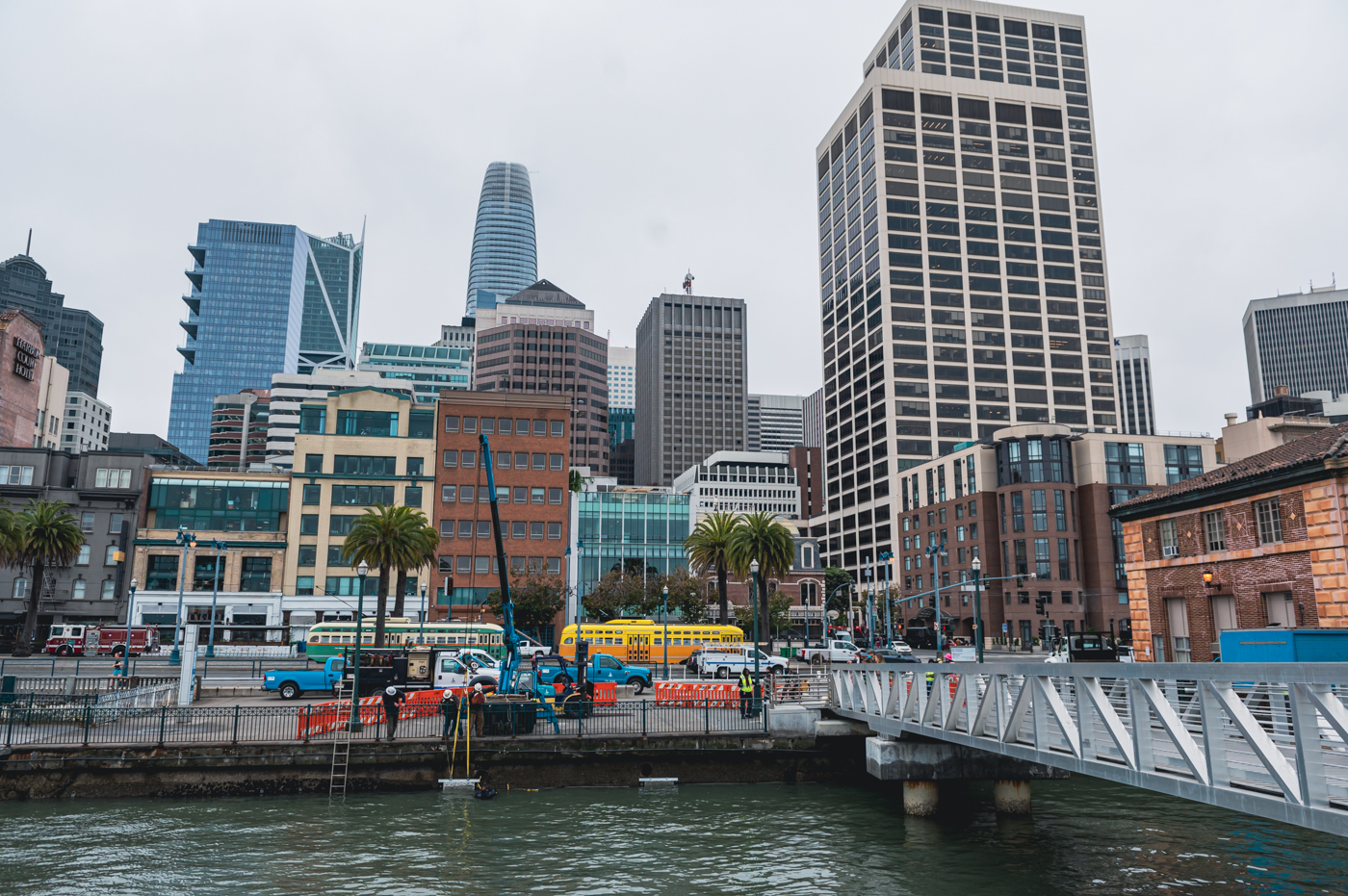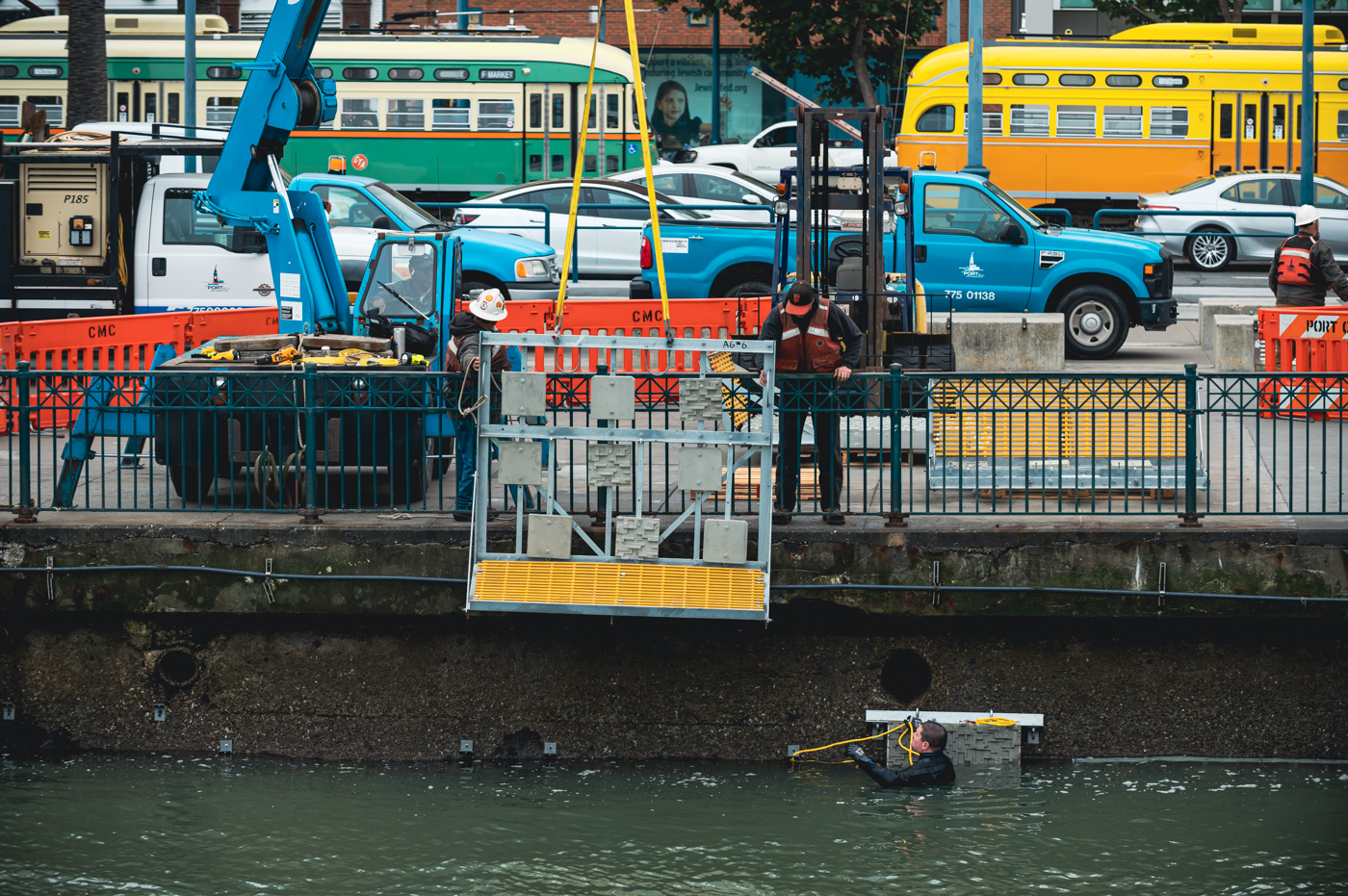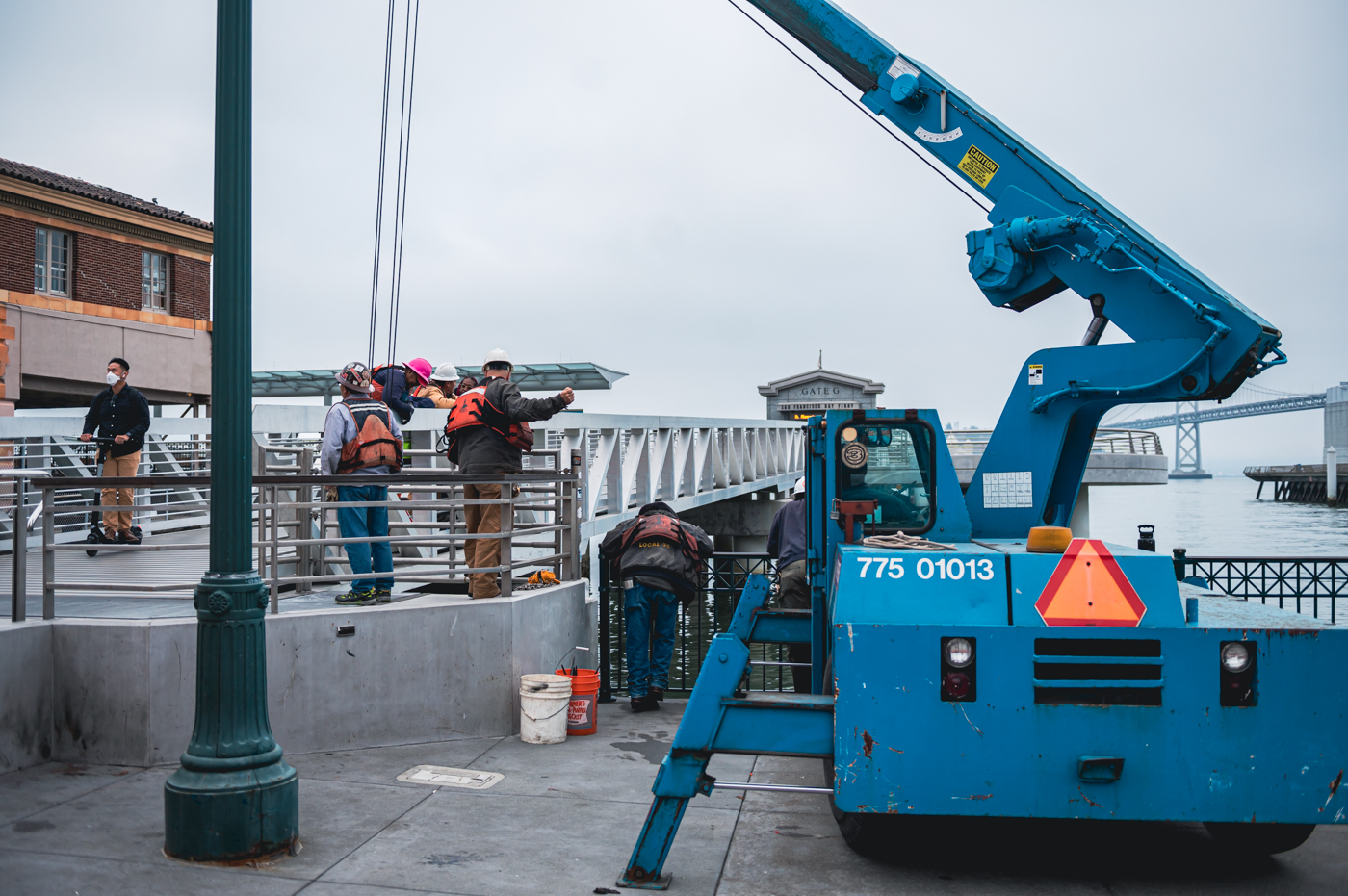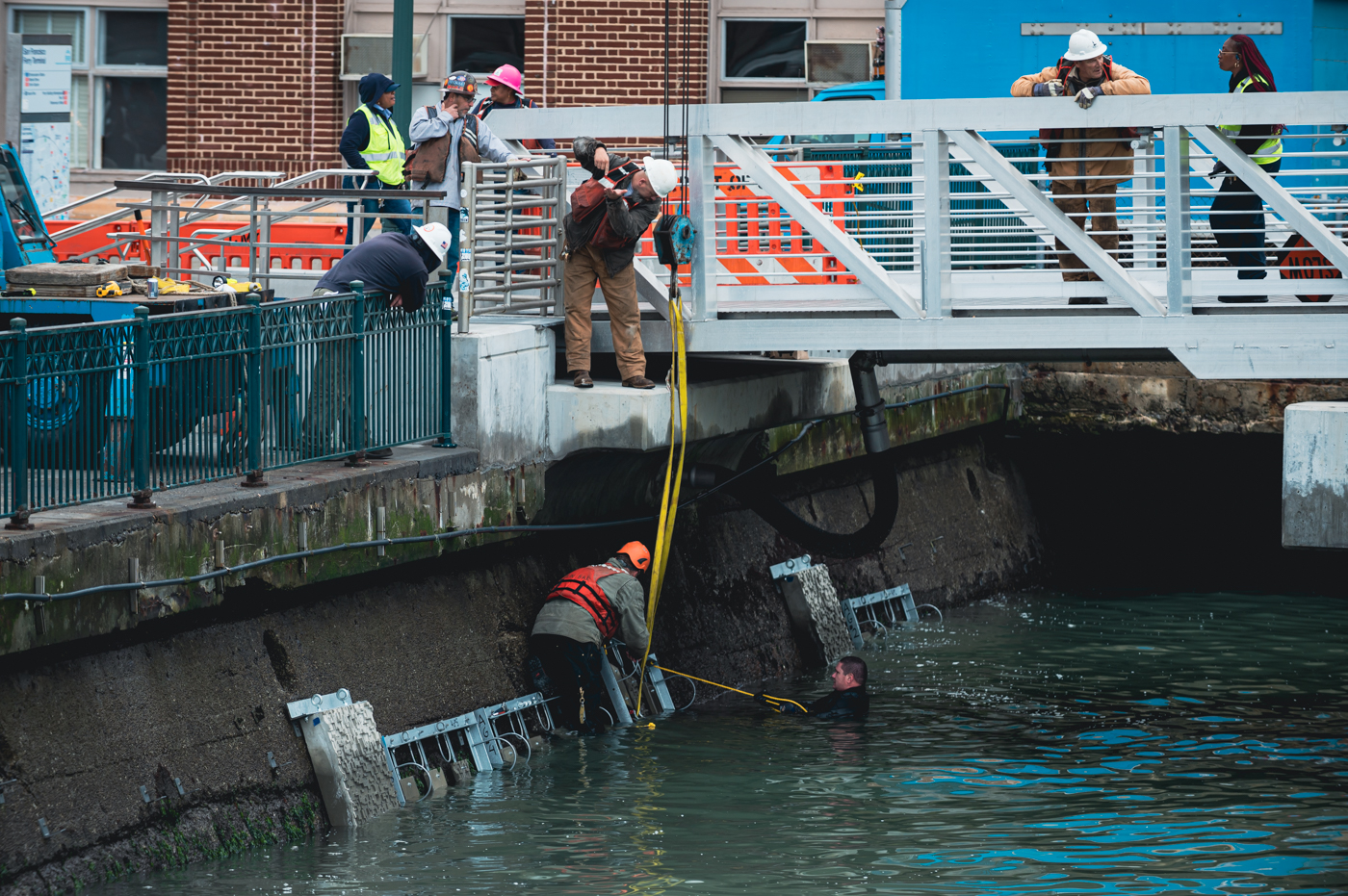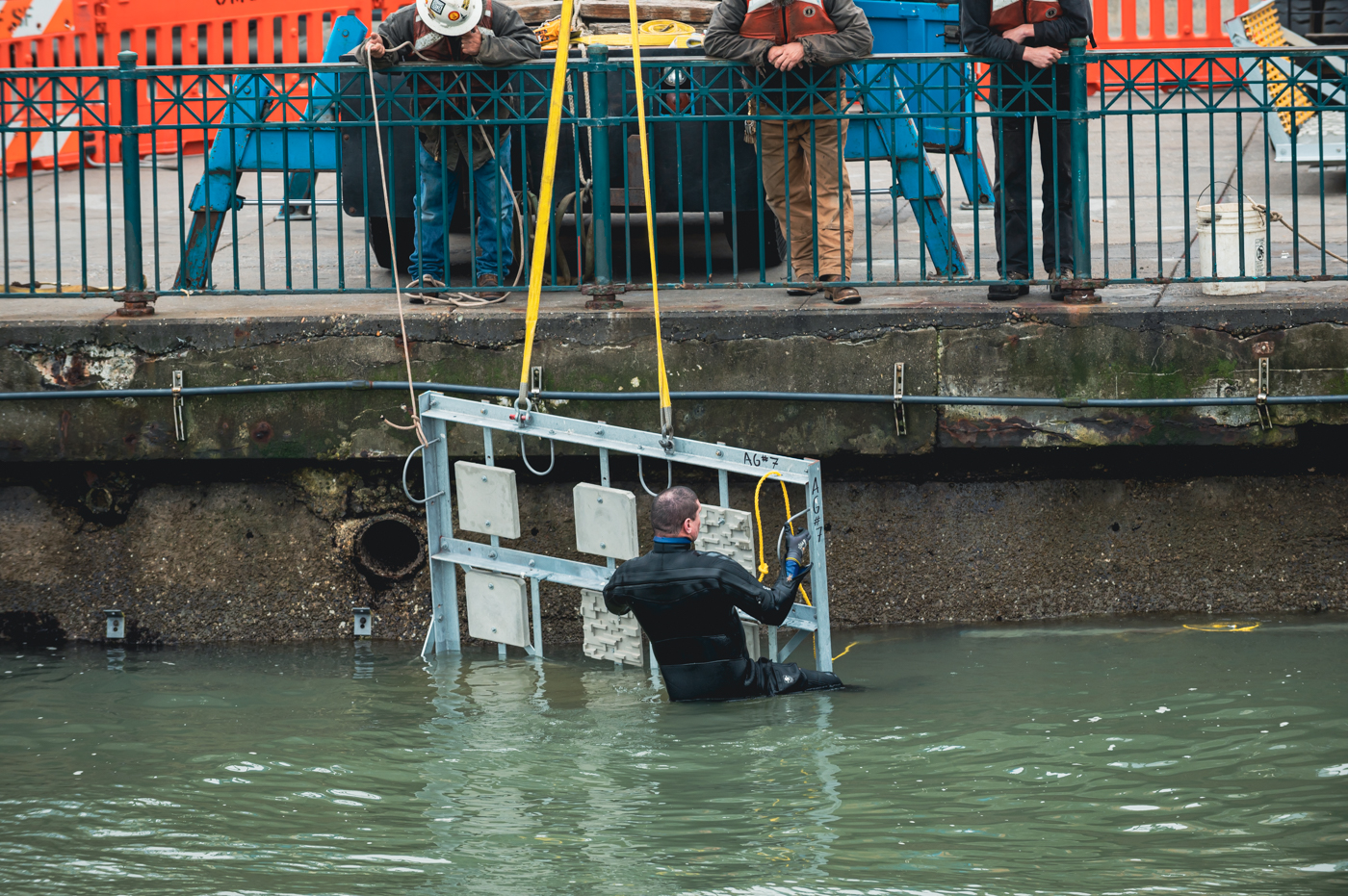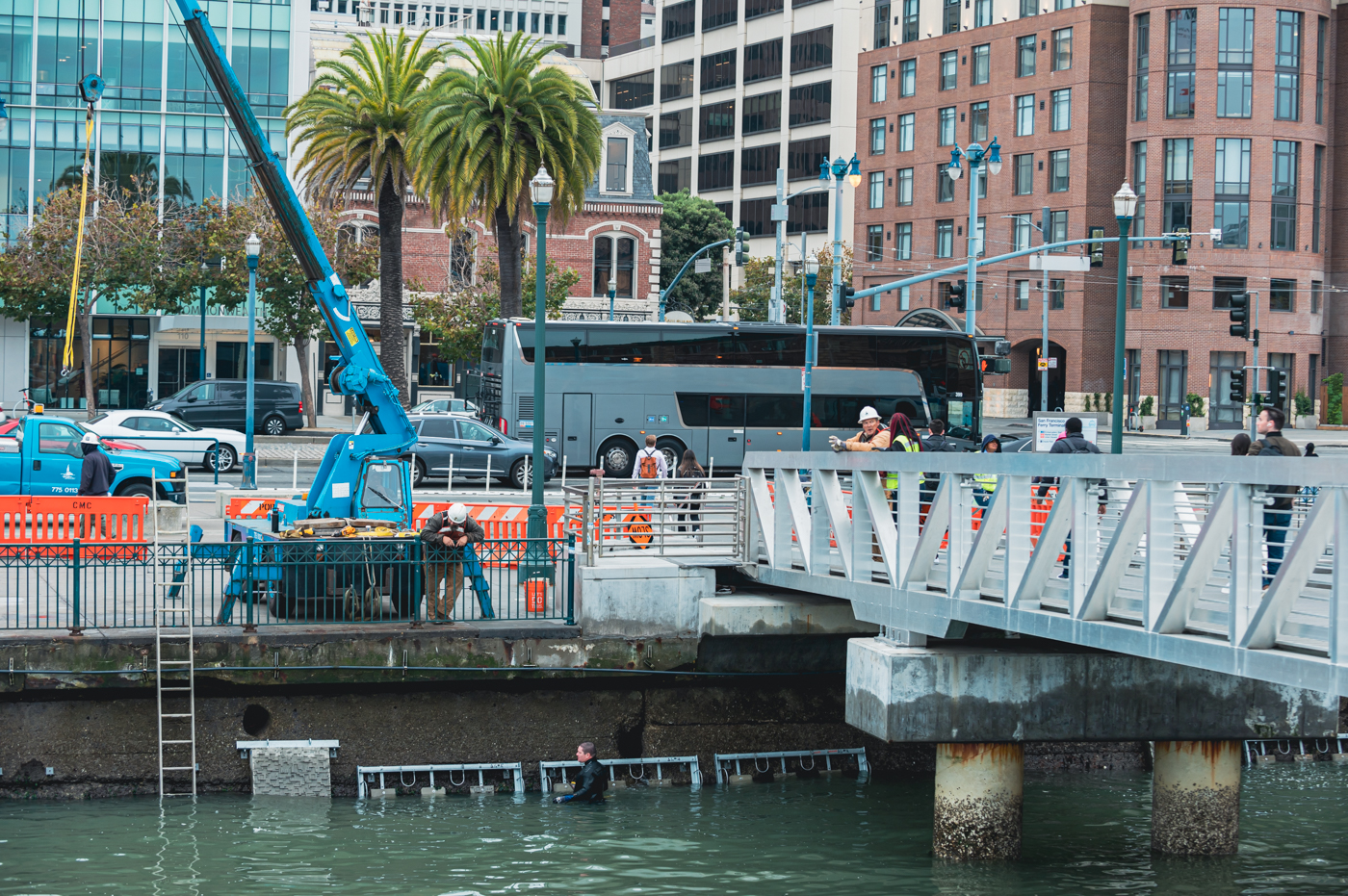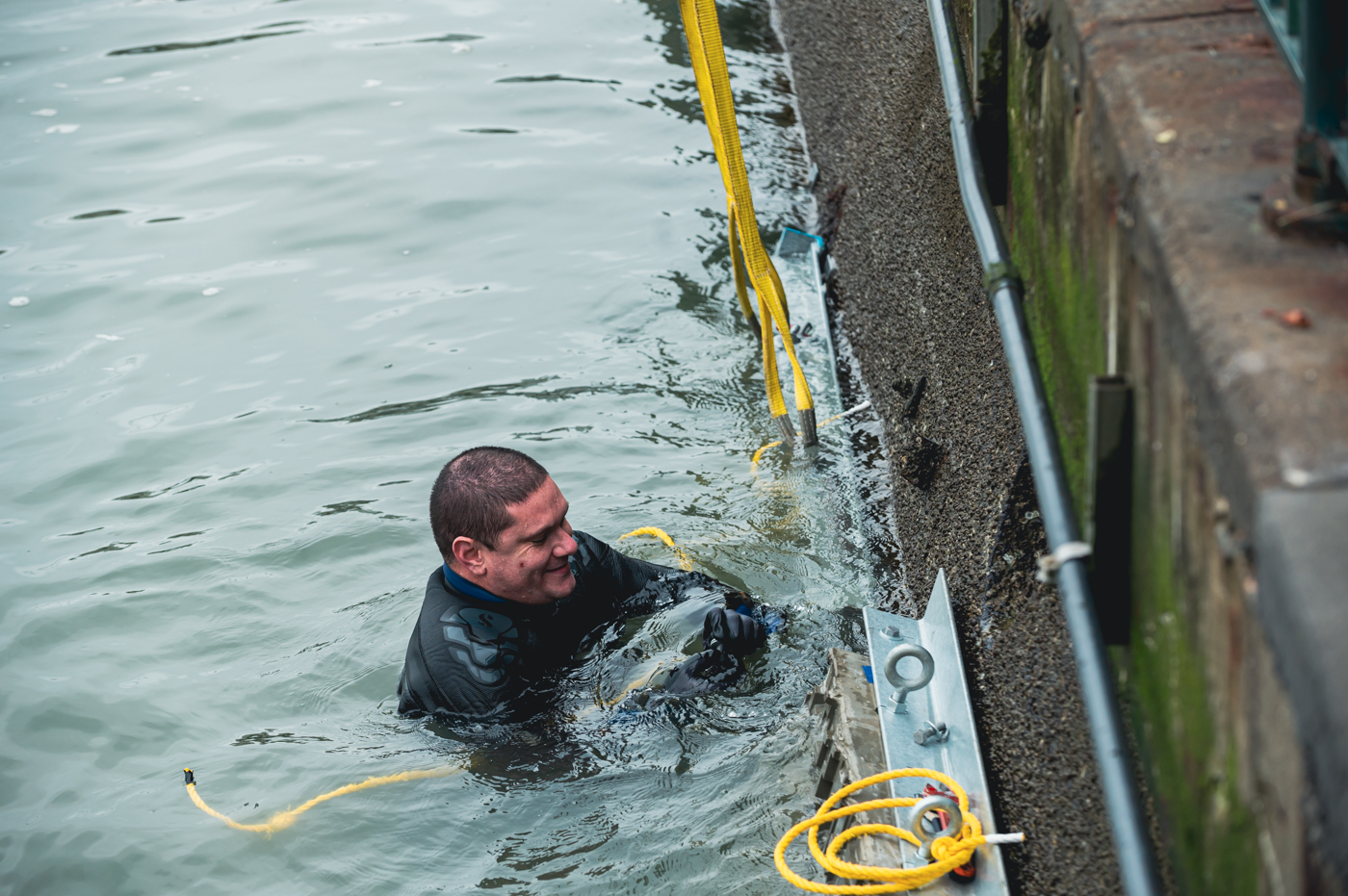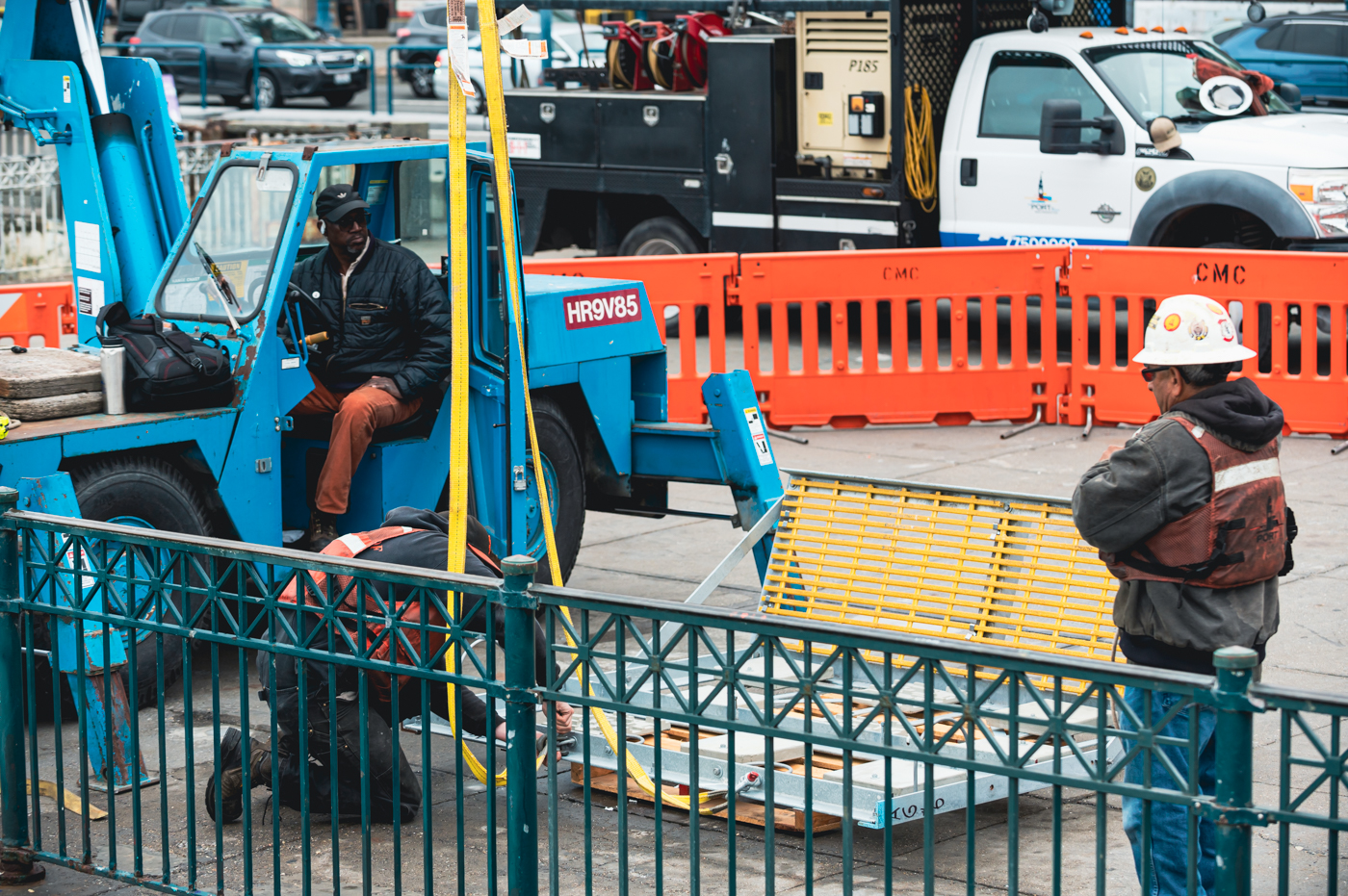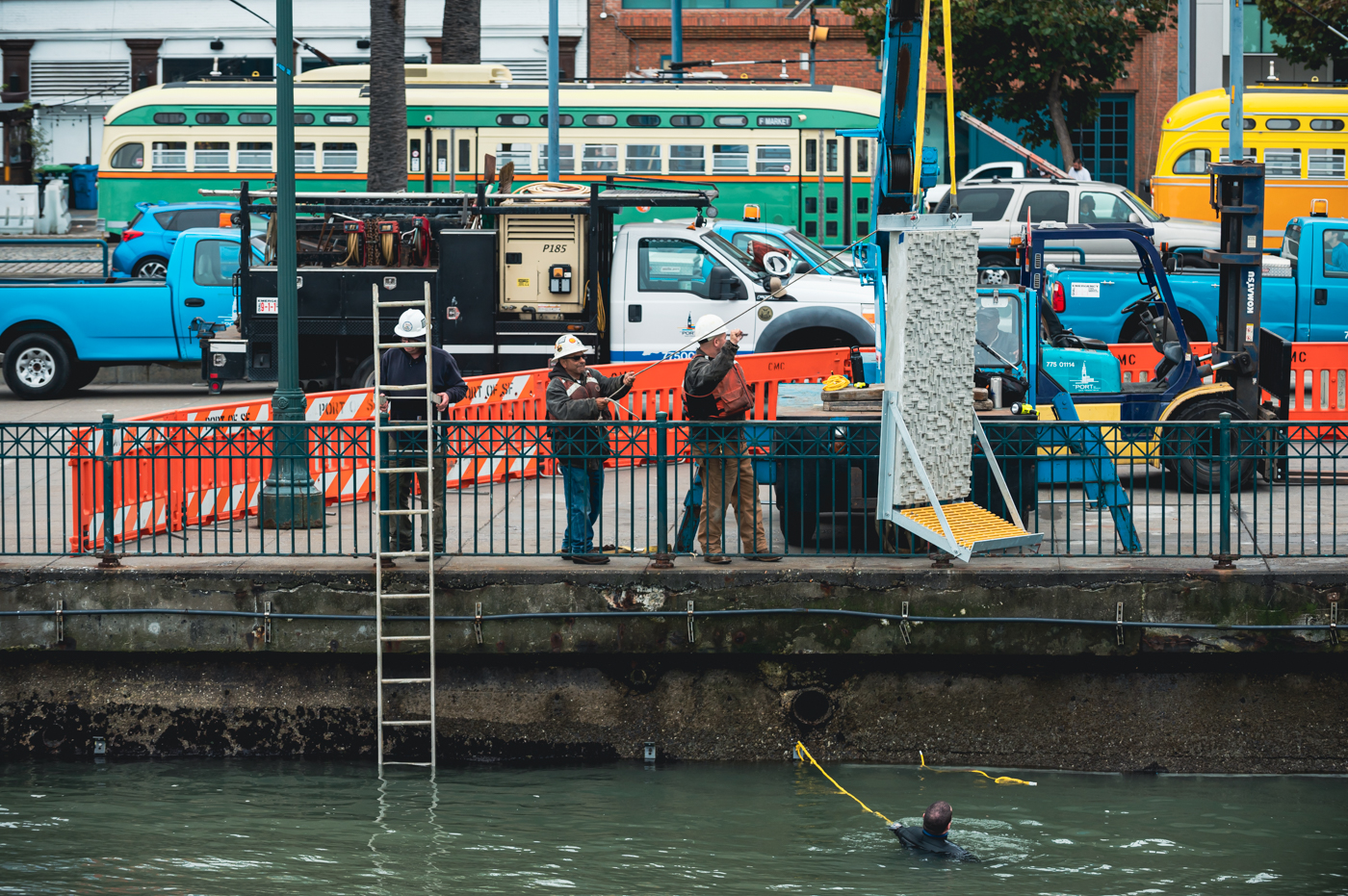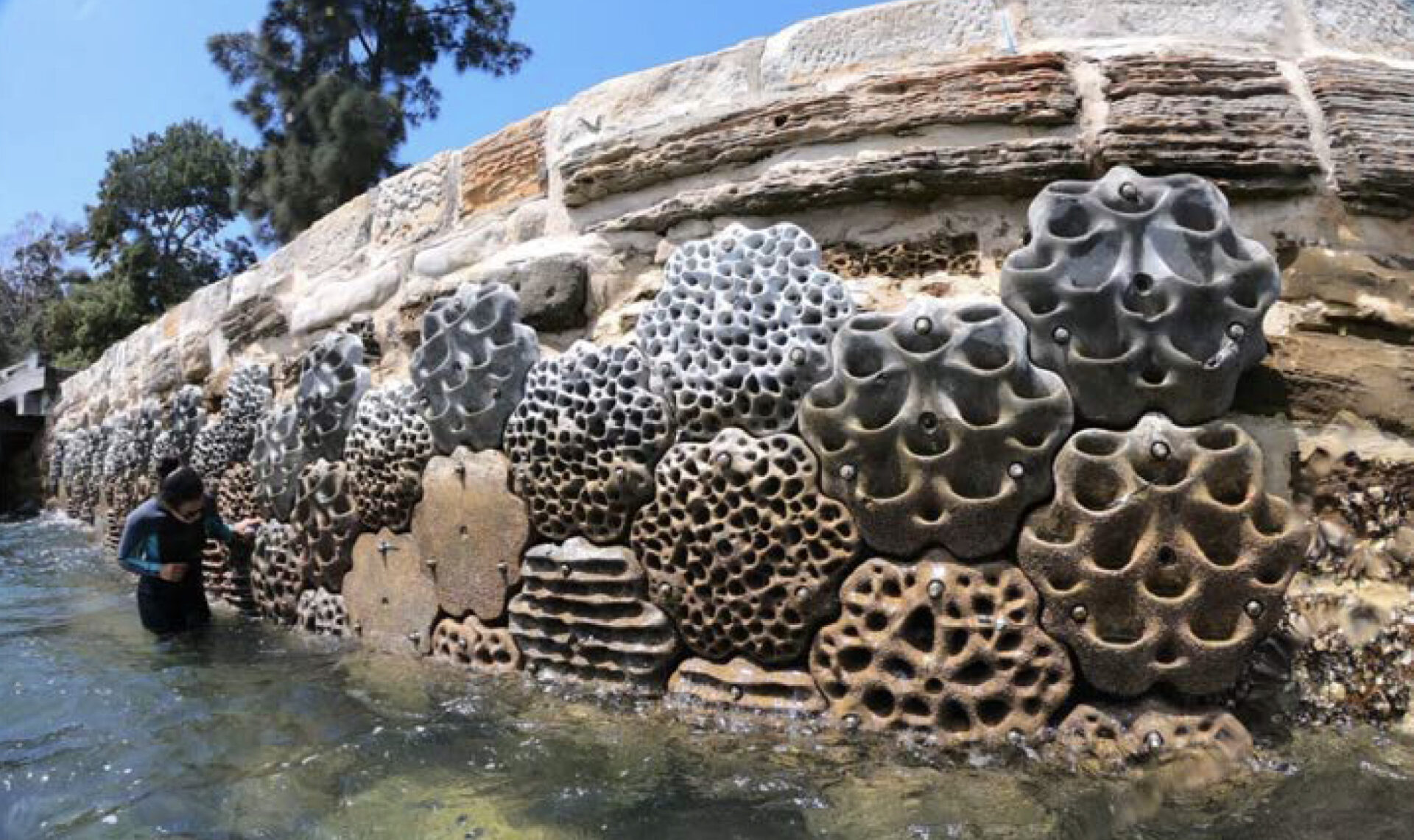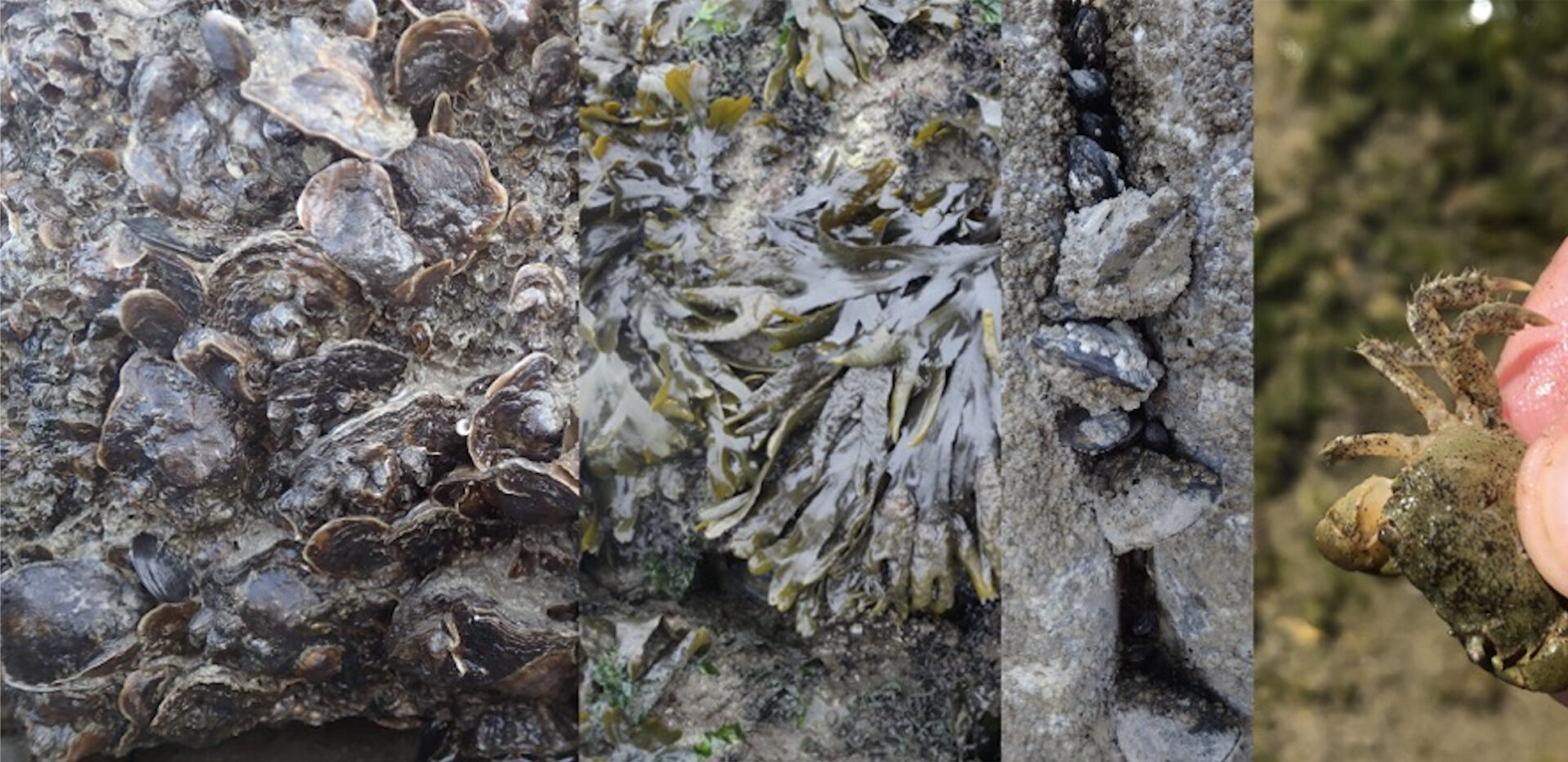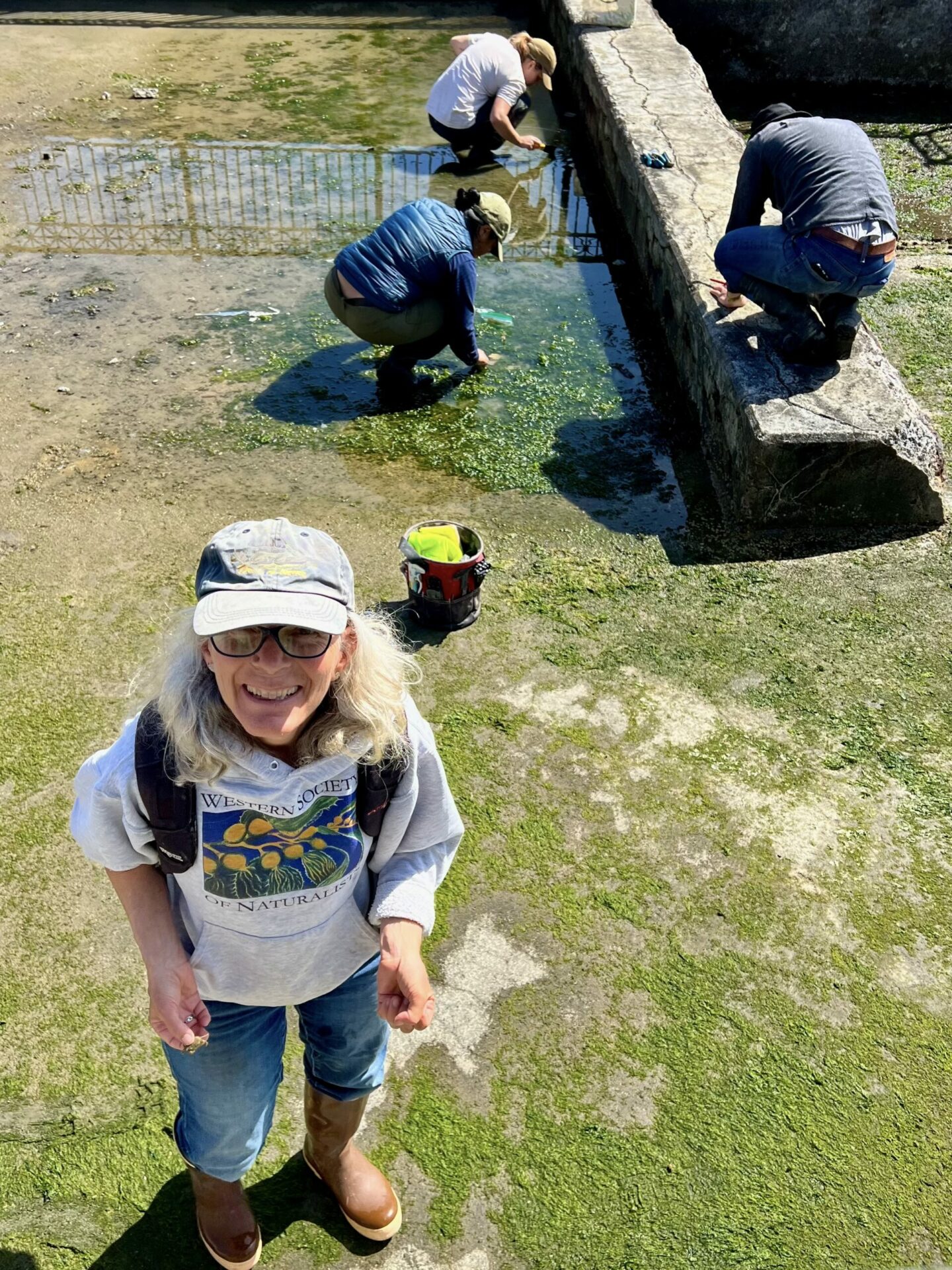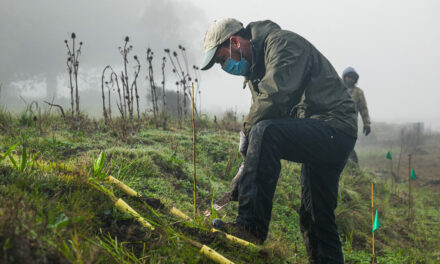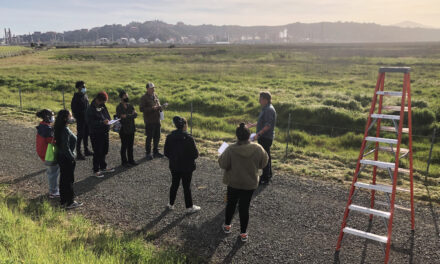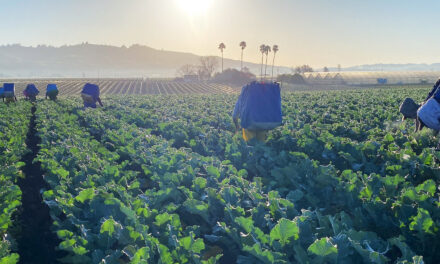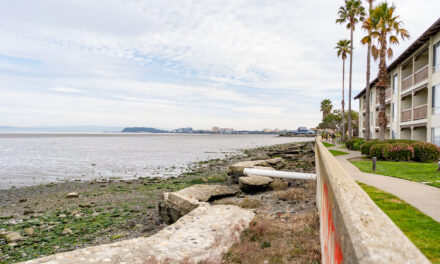Could Textured Tiles Bring SF Seawall to Life?
Most San Franciscans have no clue that under their downtown waterfront’s piers, roads, and streetcar lines sits a seawall. Few stretches of this largely underwater dike are visible to passers-by. Rebuilding the city’s century-old seawall to be both earthquake-safe and resilient to sea level rise and storm surge will be the Port of San Francisco’s mega-adaptation project of the century.
The first projects of this voter-approved and bond-funded endeavor are due to start construction in the next few years. But buried in the blueprints and engineering specs is a cutting-edge experiment in texturing pieces of the seawall so they attract and support herring, oysters, rockweed, hermit crabs and other native species of the bay’s natural rocky shore. Indeed, the first textured tiles at the heart of this two-year, million-dollar experiment went in the water on October 12 near the Ferry Building.
“If we care about native species diversity, then we want sea walls to be better habitat for them,” says the Smithsonian’s lead scientist on the project Chela Zabin. “A smooth seawall has few analogs in nature.”
The experiment compares smooth tiles, similar to a conventional seawall surface, and textured tiles inviting to aquatic life. Photo: Lonny Meyer.
The experiment will compare traditional seawall textures and marine grade concrete with some innovative surfaces molded and cast by the international company E-Concrete. These experimental tiles come in two sizes, one foot square, and three-by-six. Not only do they have texture, an “admixture” of bumps, ridges, and pockets, but also a special chemical signature marine species find attractive.
“We’re testing texture, material type, scale, and depth in the water,” says Zabin. “In terms of scale, we want to see if we get the same effect with a series of small separate tiles as we do with the same surface area but a bigger patch of it.”
This October, port divers and crew will finish installing all 288 tiles in the experiment at three different locations on or near the existing seawall: one site off the Agricultural Building near the Ferry Building and two on breakwaters off Pier 45 and South Beach Harbor (see map). Once installed, the science team will visit the installations three times a year, for at least two years, to see how marine life responds to the various sizes and surfaces, as well as how much of an impact waves, salinity, and elevation, in relation to the tides, have on colonization.
“The waves and salinity decrease as you move around our waterfront from west to south,” says Kelley Capone, who is managing the project for the Port of San Francisco.
“There’s a lot to explore in this experiment, we know this is definitely not a one size fits all situation,” says Zabin. “But the information we gain should be directly applicable to a number of other places around the Bay, including Oakland and Alameda.”
Locations for experimental tiles: 1) Pier 45 breakwater; 2) Agricultural building; 3) South Beach Harbor. Image courtesy Port of SF.
Co-designing the Experiment
Choosing sites appropriate for the installations wasn’t a piece of cake: each site sports 10 replicates, amounting to 90 small tiles and six large for each and requiring a lot of linear waterfront. “It was a challenge to find sites where we could put all of this in one stretch facing the same direction,” says Zabin.
South Beach breakwater, one of the three sites for the experiment. Photo courtesy Port of SF.
Project planners also had to consider safety and access from deep water for monitoring, as only one site is accessible on foot and even then you still have to get in the water. “We couldn’t survey by scuba diving at high tide with a camera. The Bay is so murky often you can’t see two inches in front of you!” says Zabin.
Port engineers and facilities maintenance staff helped design frames and platforms for the tiles that could be hung on breakwaters. The lowest sets of tiles can even be raised and lowered for photography. “It was exciting working with folks with such a different skill set, who could solve problems, imagine solutions, and then build them,” says Zabin.
“Our welders and engineers and laborers all really got into the science of it,” adds the port’s Capone. “For me, I just love the biology. I could listen to the scientists talk about biology all day long.”
The frames holding the tiles include platforms for the scientists to stand on, as well as hand holds and harness clip-ons for days when waves or ferry wakes could sweep them off their feet. “We’ll be going out at low tide by boat, stepping off the boat onto platforms, and then photographing the tiles,” says Zabin.
Slide show of installation on October 1. All Photos Lonny Meyer.
After safety, cost was the top priority for the port’s Capone. “We would have potentially done more sites and even monitored for longer than two years, if budget was not an issue.” The $1 million budget for the experiment, which is coming out of the bond funding, covers design, platform fabrication, tile purchase and installation, two years of monitoring and reporting, lab work, and maintenance.
An International Pilot
Texturing seawalls to benefit native species is a growing priority worldwide — both Australia’s Sydney Harbor and Washington’s Seattle have species-facing seawalls in the water already. In fact, there is plenty of published research showing that while results vary from place to place, if you add more surface complexity you get more species.
“Each area has to design for their specific conditions and their targeted species. So Seattle designed for salmon, and Sydney mimicked the roots of their natural mangroves,” says the port’s Kelley Capone. (She adds that Volvo must have funded some of Sydney’s tiles because they carry the brand name and look like hubcaps.) The port paid particular attention to the Seattle example, and how they engaged scientists in planning something that would benefit young salmon.
Five years later, monitoring results confirm the success of the Seattle project, which created everything from horizontal and slanted ledges to vertical cobble fields to support salmon. “I’m told monitoring shows tens of thousands of juveniles cruising along a waterfront they previously avoided, so wow, it worked!” says Zabin.
Textured seawall experiment in Sydney, Australia. Photo courtesy Port of SF.
At the Sydney installations, scientists are finding that different species favor different tile designs. “For me, the take home is that it’s good to have a variety of shapes and depth of holes,” says Zabin. “Even pin-sized holes in the surface seemed to attract critters.”
In a region where the focus has long been on building nature-based infrastructure such as restoring wetlands, oyster reefs or eelgrass beds at the edge of parklands, the seawall experiment stands out as an adaptation innovation for the miles of built-up bayshore that will need harder, greyer protection for rising sea levels and storm surge.
“In my view, for the port, the entire seawall project is turning a page. We’re really looking at how to incorporate natural processes and add things to our gray infrastructure that will benefit the environment or reflect specific local habitats. The port and the city really want to maximize engineering with nature. What we find is, when you really incorporate nature into your designs, you have a better project that lasts longer and requires less maintenance. You’re not fighting nature the whole time, you’re incorporating it,” says Capone.
Humble and Proud Port
Though few San Franciscans may have seen the seawall with their own eyes, hidden as it is below giant piers and the Embarcadero, voters were aware enough of it to approve a bond for the Port’s larger seawall improvement project by almost 83% in 2018. The Port is pleased to have so much public support for a project that will take decades to complete, says Brad Benson, director of the port’s Waterfront Resilience Program. In addition to launching the living seawall experiment, the port recently released details on seven early waterfront adaptation strategies and projects, which are well described in an October 11 San Francisco Chronicle by John King.
“We’ve made some pretty intensive efforts to develop improved habitat along our southern waterfront, at Heron’s Head and Pier 94, but we look at this investment of billions of dollars in the seawall as an opportunity to introduce much better habitat conditions to the seawall itself. This experiment will be foundational work in thinking about how we might design that future seawall,” says Benson.
Port commissioners are strongly supportive of the living seawall experiment according to Benson. The Port has also developed an “Engineering with Nature” work group to support the larger waterfront-wide project, consisting of local experts, as well as experienced practitioners and scientists from Seattle, UK, and Australia. The team also conducted interviews with the local fishing community
“We want to know what’s the best the seawall can be to function as flood protection, be seismically safe, and do the least harm to the environment,” says Capone.
“We are hoping to embed appropriate nature-based measures as much as possible across the project area to increase resilience for people and wildlife into the future,” says U.S. Army Corps biologist Julie Beagle, who is working with the project team and engineering with nature group.
Beagle says the port’s larger waterfront resilience project is an example of the Corps’ move toward evaluating projects using a framework called “comprehensive benefits,” which she describes as nature-based measures that can provide flood risk reduction, improved habitat, as well as recreational value and other services not often captured by pure dollar amounts.
Using nature-based approaches in a deep-water environment is hard. But San Franciscans are sure to demand cutting edge adaptations such as small beaches, living breakwaters, as textured seawalls on their urban bayshore.
Species scientists and planners are hoping will embrace the new seawall texture include Olympia oysters, rockweed, mussels, and crabs. Photos: Chela Zabin.
Zabin is hopeful. “It can take a while for organisms to assemble, and the Bay can vary from year-to-year, but I’m excited to see what comes to live on the tiles.”
“We’re trying to approach this project with a measure of humility, and there’s a lot that we have to learn. Are we going to attract the types of target species we hope for? We don’t want to be in a position of promoting more non-native invasive species. Also, we really do want to continue to engage with the public. Depending on which adaptation strategies the public coalesces around, I think we’ll have exciting opportunities ahead. But we’re just at the beginning,” says Benson.
Chela Zabin, with Smithsonian crew surveying existing species on the seawall. Photo: Maureen O’Malley.
The youngest members of the public, however, clearly get it. When kids look at the kinds of textured surfaces Zabin lays out at science fairs, they choose the nooks and crannies every time: “They have no problem imagining themselves as a crab trying to find a nicer place to live.”







